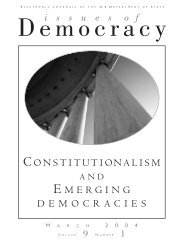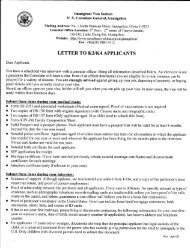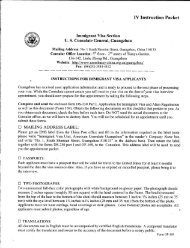Terrorism: Threat Assessment, Countermeasures and Policy
Terrorism: Threat Assessment, Countermeasures and Policy
Terrorism: Threat Assessment, Countermeasures and Policy
You also want an ePaper? Increase the reach of your titles
YUMPU automatically turns print PDFs into web optimized ePapers that Google loves.
BRINGING TERRORISTS TO JUSTICE<br />
UNDER THE RULE OF LAW<br />
By Peter Raven-Hansen<br />
Glen Earl Weston Research Professor of Law, The George Washington Law School<br />
“Bringing terrorists to justice under the rule of law is a slow, cumbersome, inefficient business,” says<br />
George Washington Law School Professor Peter Raven-Hansen. Nevertheless, the United States<br />
continues to apply the rule of law in the investigation <strong>and</strong> prosecution of the global war on terrorism.<br />
“The United States has responded to terrorist attacks with the same tools of criminal justice:<br />
surveillance, arrest, detention, <strong>and</strong> trial.”<br />
The history of lawless police states leaves little doubt<br />
how one would respond to a terrorist attack. The<br />
government would declare a national emergency to<br />
invoke new “emergency” powers <strong>and</strong> measures. Already<br />
secretly tracking many citizens, the police would<br />
exp<strong>and</strong> surveillance in a search for the attackers. They<br />
would quickly arrest suspects, potential witnesses, <strong>and</strong><br />
maybe dissidents <strong>and</strong> critics as well. The arrested<br />
would be held in isolation <strong>and</strong> possibly abused to make<br />
them talk. Finally, the authorities would first secretly<br />
decide who is guilty (or who should be called guilty)<br />
<strong>and</strong> afterwards announce that judgment in show trials,<br />
followed by execution or long terms of imprisonment.<br />
A lawless response would be swift <strong>and</strong> seemingly<br />
efficient because it could be decided personally by one<br />
or a few men whose orders are “law” to their underlings.<br />
The United States has responded to terrorist attacks<br />
with the same tools of criminal justice: surveillance,<br />
arrest, detention, <strong>and</strong> trial. But in a state ruled by law<br />
rather than personal fiat, these tools are not crafted by<br />
President Bush <strong>and</strong> his counselors. They were instead<br />
authorized by pre-existing laws in the U.S.<br />
Constitution, legislation enacted by Congress, <strong>and</strong><br />
executive regulations. Furthermore, with few<br />
exceptions, the only U.S. “emergency powers” are ones<br />
given the President by laws which Congress has<br />
previously passed, not ones he gives himself because he<br />
thinks it necessary. And if the tools provided by law<br />
prove to be too slow <strong>and</strong> cumbersome to meet the<br />
terrorist threat, they must be changed by a public<br />
legislative process, not by presidential order.<br />
29<br />
SURVEILLANCE<br />
The U.S. Constitution protects the people from<br />
“unreasonable searches <strong>and</strong> seizures.” To be reasonable,<br />
a search — whether conducted physically in the home<br />
or electronically by wiretap or other communications<br />
intercept — must ordinarily be pre-approved by an<br />
independent judge on evidence showing that there is<br />
probable cause to believe that evidence of a crime will<br />
be found. Evidence obtained in violation of these<br />
st<strong>and</strong>ards can be thrown out of court. But the U.S.<br />
Supreme Court has recognized that collecting security<br />
intelligence is different from collecting evidence of a<br />
crime, partly because it is needed to prevent spying or<br />
terrorism <strong>and</strong> not just to solve completed crimes.<br />
Congress has therefore enacted a law permitting<br />
independent judges to authorize surveillance for the<br />
purpose of collecting foreign intelligence on a lesser<br />
showing of probable cause. The government need only<br />
show that there is probable cause to believe that the<br />
target of the surveillance is a foreign agent or<br />
international terrorist.<br />
Such foreign intelligence surveillance was already being<br />
conducted before the September 11 attacks on the<br />
United States, <strong>and</strong>, indeed, had produced crucial<br />
evidence against the terrorists who were ultimately tried<br />
for the 1998 bombings of the U.S. embassies in<br />
Tanzania <strong>and</strong> Kenya. But the law before September 11<br />
also restricted some surveillance. U.S. newspapers<br />
report, for example, that before September 11 the<br />
government was unable to make the showing required<br />
to obtain surveillance of one of the men now suspected












